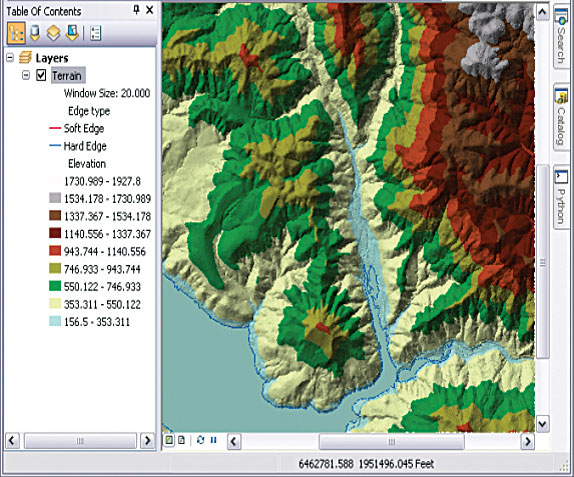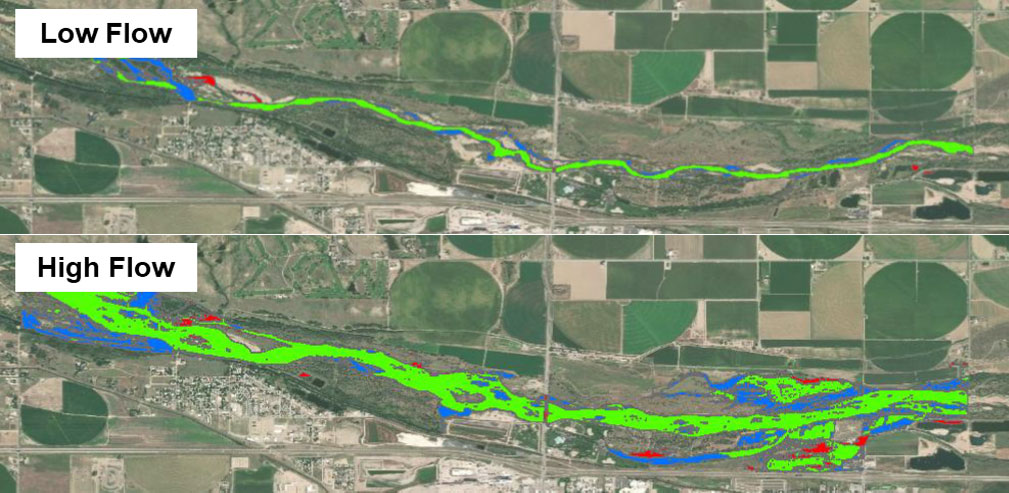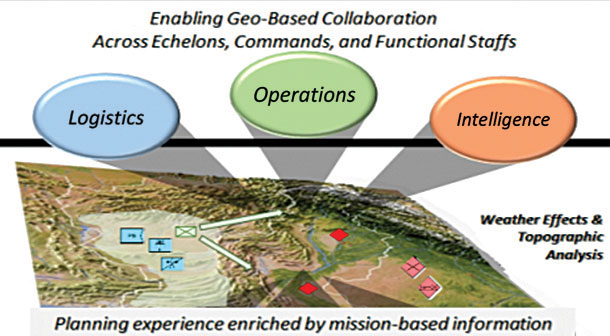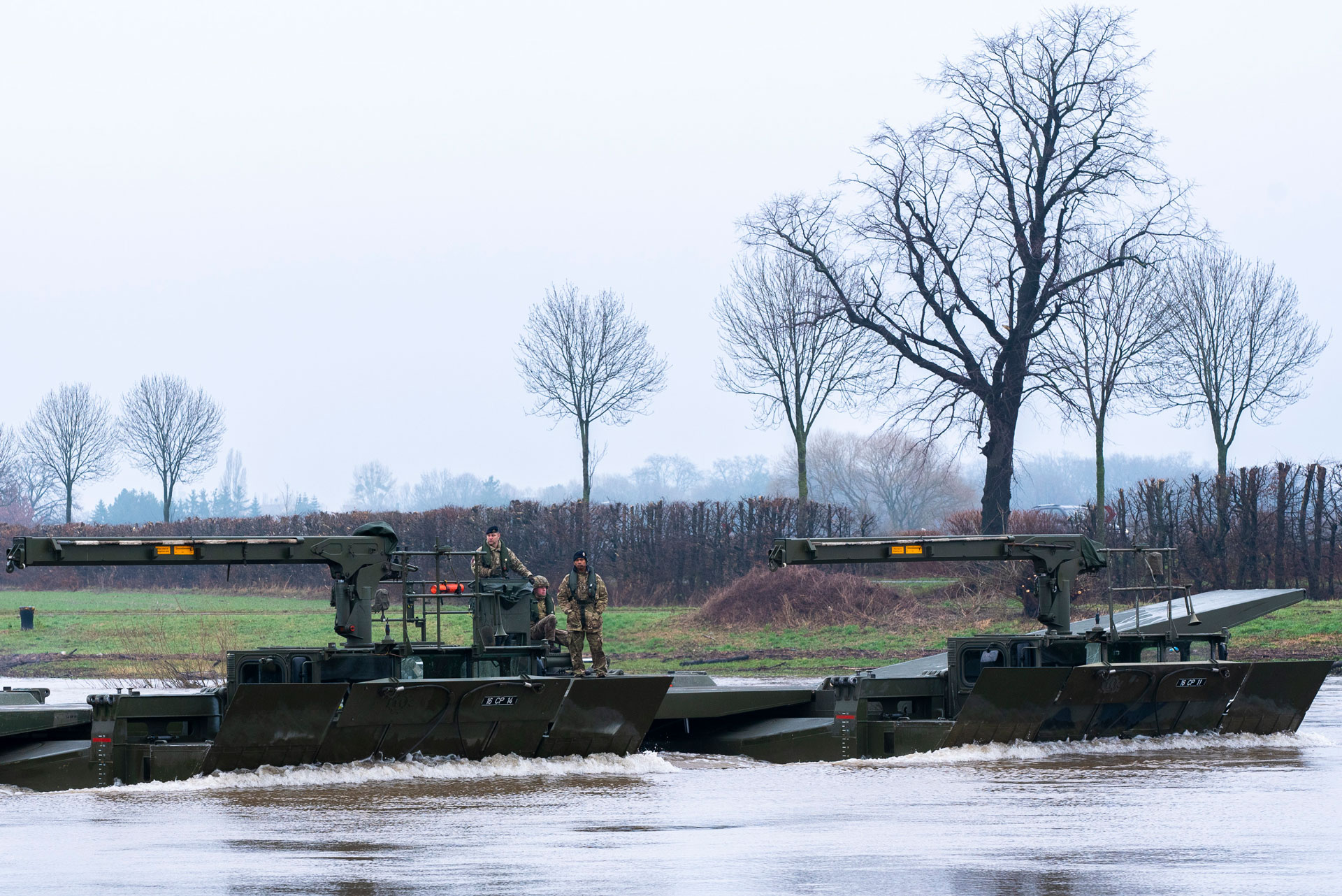
OVER THE RIVER: NATO Allied Rapid Reaction Corps officers visit British Royal Engineers in Germany as they prepare for river crossing drills in February. ERDC’s Streamflow Prediction Tool provides 15-day continental scale streamflow forecasts to allow planners to quickly gauge river crossings in any part of the world. (Photo by British Army Sgt. Alistair Laidlaw)
The Army ERDC supports multidomain operations, creating a transformation in battlefield situational awareness and planning through advanced geospatial technologies.
by Dr. Robert Davis and William Jones
The second in an occasional series of articles about the U.S. Army Engineer Research and Development Center’s (ERDC) support to multidomain operations.
When military leaders refine battle plans and prepare for multidomain operations, they must have access to robust geospatial and environmental information about their operational area. Army leaders highlighted the critical need for a common operating picture in the document outlining the Army’s operations concept, calling it one of the two “most important technical shortfalls” in its capability to achieve joint convergence. “The U.S. Army in Multi-Domain Operations 2028” stresses the importance of a shared visualization and decision support tool available to commanders in any service and at any echelon.
The multidomain operations concept requires a changed paradigm in the way actionable geospatial and environmental information is used. Digital maps alone will not suffice. Instead, the underlying common operating environment must allow commanders to access relevant terrain, weather and environmental information. Emerging geospatial capabilities now enable commanders to visualize the common operating picture in four dimensions—a full three-dimensional view plus the dimension of time. Actionable geo-information and decision tools must empower the planning of command-and-control activities at the appropriate level. Geospatial and environmental information and implementation concepts have matured and can now be incorporated into the common operating environment. The convergence of the complex, previously stovepiped systems now fosters interoperability, automation, resilience, robust analysis and speed.
Terrain, weather and other battlefield environmental effects fundamentally inform planning, situational awareness and the decision-making processes within the mission command warfighter function. These conditions each impact force tactics and behaviors, platform performance (ground and air), system performance (e.g., sensors) and the Soldier. For example, in planning converging strike capabilities across multidomain formations, planning teams require precision and exquisite knowledge of the terrain, weather and environment, tailored to how they may impact potential courses of action. Calibrating force posture and maneuvering multidomain formations into tactical areas heavily protected by enemy anti-access and area-denial systems requires similar information, readily available for decision making across echelons and the joint services.
The U.S. Army Engineer Research and Development Center (ERDC) is DOD’s lead in research on terrain and the Army’s key to geospatially enabling mission planning and mission command, and is home to the only DOD laboratory whose sole mission is environmental research. As such, the center is fully engaged in research to meet the needs of multidomain operations. Its geospatial and environmental expertise and technologies help the warfighter understand the terrain and the operational environment across a range of users and platforms to support key decisions affecting mission command, maneuver, logistics, intelligence and fires. Key use cases include mission planning; determining and visualizing enemy capabilities; planning and visualizing weapons effects in a three-dimensional urban terrain; applying terrain analysis; optimizing intelligence, surveillance and reconnaissance planning; and supporting movement and maneuver in complex terrain.
The center has transitioned several major programs to meet the need for a new generation of actionable geospatial and operational environment information, and it has plans to transition more.

LIDAR MAPPING: ERDC researchers built a 3D “point cloud” view of the Muscatatuck Urban Training Complex in southeast Indiana in December 2018. The point cloud derives from an overhead collection of airborne LIDAR data to establish a reference data set for 3D mapping of infrastructure. (Photos courtesy U.S. Army ERDC)
MORE THAN A MAP
Existing planning tools do not allow operational leaders to communicate a commander’s intent, operational purpose and desired end state during rapidly changing operations. Recognizing this, ERDC developed a digital, geospatially enabled planning environment that provides multiple forms of collaboration within the tactical, operational and strategic communities.
Map-Based Mission Planning is a joint research program that enables the sharing of ideas and situational understanding between superiors, subordinates and peers in all phases of military planning processes. Its geospatially enabled capabilities allow planners to collect, process and share information and make informed decisions in near real-time.
Analyzing the effects of weather, terrain and even urban-area concerns, the program continuously gathers logistics, intelligence and operational information to support decision making by utilizing authoritative databases. It provides an updateable and interactive common map to be used by leaders, and it can flag hazards, such as terrain likely to flood during a certain time of year or routes that take Soldiers through hazardous-material areas, to reduce maneuverability risks.
The program enables all elements of the force to operate on the same map and supports real-time coordination and collaboration.

DANGER OF FLOOD: ERDC’s Streamflow Prediction Tool produces 15-day continental scale streamflow forecasts for each river, stream and tributary, including an intuitive warning system that highlights areas most likely to experience flooding.
IT LOOKS LIKE RAIN
ERDC has developed a variety of environmental modeling platforms and intelligence tools designed to support the planning process and be integrated into the toolbox of the common operating environment.
Weather impacts how commanders select objectives and how they locate, move and control forces. Poor weather can significantly diminish Soldier and weapon system performance. Yet, the Army faces a challenge to integrate weather with geospatial services or to fully understand how the weather impacts the terrain across functions and courses of action. ERDC researchers solve this difficulty by merging diverse core competencies across the center’s seven laboratories.
They have adapted the NASA Land Information System (LIS), a modeling software package, to generate a number of military geospatial and environmental products. The Army Terrestrial-Environmental Modeling and Intelligence System (ARTEMIS) transitioned technologies to the Army’s Distributed Common Ground Station, which directly supports mobility and maneuver planning, military hydrology, austere entry, geospatial awareness, and other battlespace-awareness and mission planning capabilities. With the ability to mine vast amounts of land surface modeling data, weather forecasting and climate models, ARTEMIS improves geospatial awareness of the changing environment at the tactical level, enhancing situational understanding and improving predictive capabilities. Example tools include Geospatial Tactical Route Analysis in Complex Environments (GeoTRACE), decision aids for lightweight dismounted operations to determine optimal routes based on factors such as minimal slope, shortest time, caloric expenditure or altitude impacts.
In 2019, ERDC began development of a tool to inform the Army of hazards such as toxic threats to the warfighter that must be avoided in mission planning. This tool, Understanding the Environment as a Threat, includes capability to locate industries, identify toxic industrial chemicals and materials, and predict the threat in air, soil and water. The tool also will provide updated toxicity profiles and subterranean reverse-point adversary sourcing, while using a hazard-based weigh-risk routing option.

ECO INSIGHT: In the multidomain-operations environment, the Army’s freedom of maneuver will be limited by a lack of knowledge of natural environmental constraints. ERDC offers tools that integrate its geotechnical, hydrologic, environmental and cold regions expertise into high-fidelity geospatial overlays.
ERDC’s newly initiated Intelligent Environmental Battlespace Awareness project will allow the warfighter to better identify environmental terrain constraints and natural battlefield barriers. It will deliver improved understanding of soil, snow, ice and hydrological conditions.
In the later part of 2020, ERDC will begin developing a sensor system that can detect and identify biological hazards in the environment, particularly those found in subterranean environments. The project, “Sensing in Contested Environments,” will integrate with standard Army robotic platforms, as well as the Instrument Set, Reconnaissance and Surveying system (commonly known as ENFIRE), to inform the common operating picture.
ERDC’s hydraulics expertise provides additional intelligence to mission planners. The robust Streamflow Prediction Tool produces 15-day continental-scale streamflow forecasts for each river, stream and tributary. This includes an intuitive warning system that highlights areas most likely to experience flooding based on the 15-day forecast.
The interactive map-based web interface is easy to access and understand, allowing planners to quickly gauge river crossings in any part of the world and determine whether an unusually high waterway will disrupt the ability to execute a pre-planned route. Ongoing collaboration with the United Kingdom Meteorological Office involves evaluating various land surface models to identify optimal configurations for estimating streamflow. This is a great example of how ERDC is able to apply technology developed in its civil works mission space to challenges faced by the military.

TECH TRANSFER: ERDC’s Streamflow Prediction Tool is a great example of how ERDC is able to apply technology developed in its civil works mission space to challenges faced by the military.
THE URBAN TOOLKIT
The Army considers urban combat inevitable. Doctrine developers see it as a flowing series of tactical unit decisions and actions, which will greatly benefit from rich and intuitive space-, event- and trend-context. From the perspective of mission command, the multidomain-operations concept points to higher complexity, hyperactivity and faster and shorter engagements in all domains, including the electromagnetic spectrum and the information environment.
This implies the critical need to greatly accelerate commander decision time with shorter reaction windows, increased ability to deal with raw data and decreased processing staff time. Accordingly, ERDC, with its Combat Capabilities Development Command partners, has begun research into designing and formulating new urban terrain data models, frameworks and cognitive display approaches. These products will enable wide tactical distribution, sharing and analysis, while delivering the right level of detail across the common operating environment.
ERDC’s Geospatial Intelligence and Complex Urban Environments technology is one example. It provides enhanced situational awareness and terrain analysis for dense urban environment operations. Technologies enable high-resolution 2D and 3D data collection on hand-held devices, including inputs from LIDAR (a surveying technology that measures distance by illuminating a target with a laser light) sensors to survey and map underground structures and building interiors, as well as to define complex urban environments. These technologies allow merging of high-altitude, low-altitude, surface and subsurface sensor data. They also have demonstrated low-cost unmanned sensors that allow rapid situational understanding in dense urban areas, in addition to tools that provide enhanced ground-based imaging for routine use.
Small units require specialized geospatial analysis tools for complex urban environments, such as ERDC’s Urban Landscape Terrain Reasoning and Analysis tool. It uses knowledge about Soldier equipment loads, terrain, roads and population density—as well as dynamic information such as enemy positions, local civilian behavior, weather and other factors. It enables units to rapidly plan unconventional missions in urban environments, providing new options to support small team movement in a true three-dimensional depiction of urban infrastructure displaying subterranean, interior and rooftop pathways.

ON THE SAME PAGE: ERDC’s Map-Based Mission Planning program allows planners to collect, process and share information. It enables all elements of the force to operate on the same map and supports real-time coordination and collaboration.
CONCLUSION
Preparing for multidomain operations in areas that are heavily guarded by enemy anti-access and area-denial systems, or that are inherently complex, requires advanced knowledge of the terrain, weather and environmental factors specific to military operations. Analysis tools must inform mission planners’ options and alternative courses of action. Deriving and delivering useful information from an increasing volume, variety and velocity of data will be critical to success in the anticipated complex operational environments.
With a long history of terrain and environmental expertise for the Army and DOD, ERDC stands ready to provide this information on a variety of platforms that can be easily accessed by mission leaders, from high-echelon planners to Soldiers in the field at the tactical edge. That information is strengthened by ERDC’s understanding of environmental factors and how they affect the terrain warfighters will encounter, as well as its ability to incorporate that knowledge into its geospatial tools.

WATER MOVEMENT: Staff officers from NATO’s Allied Rapid Reaction Corps visit British Royal Engineers in Minden, northwestern Germany, as they prepare for river crossing drills in February. (Photo by British Army Sgt. Alistair Laidlaw)
For more information, contact ERDCinfo@usace.army.mil
To read the first in the series, go to: (https://asc.army.mil/web/news-alt-jfm20-engineering-the-theater/.
ROBERT DAVIS is the chief scientist and senior scientific technical manager for Geospatial Research and Engineering and the technical director for Army programs at the Cold Regions Research and Engineering Laboratory, part of ERDC. He holds a Ph.D. in geography, an M.A. in geography and a B.A. in geology and geography.
WILLIAM JONES is an associate technical director at ERDC. He works to maximize the contribution of the built and natural environment to enable mission effectiveness and operational success from the Army’s installations to the battlefield. He is responsible for delivering advanced environmental and military installations technologies to the Department of the Army and the Soldier through basic and applied research and development. He received his master’s and his bachelor’s degrees from Mississippi College.
Read the full article in the Summer 2020 issue of Army AL&T magazine.
Subscribe to Army AL&T News – the premier online news source for the Army Acquisition Workforce. ![]() Subscribe
Subscribe







